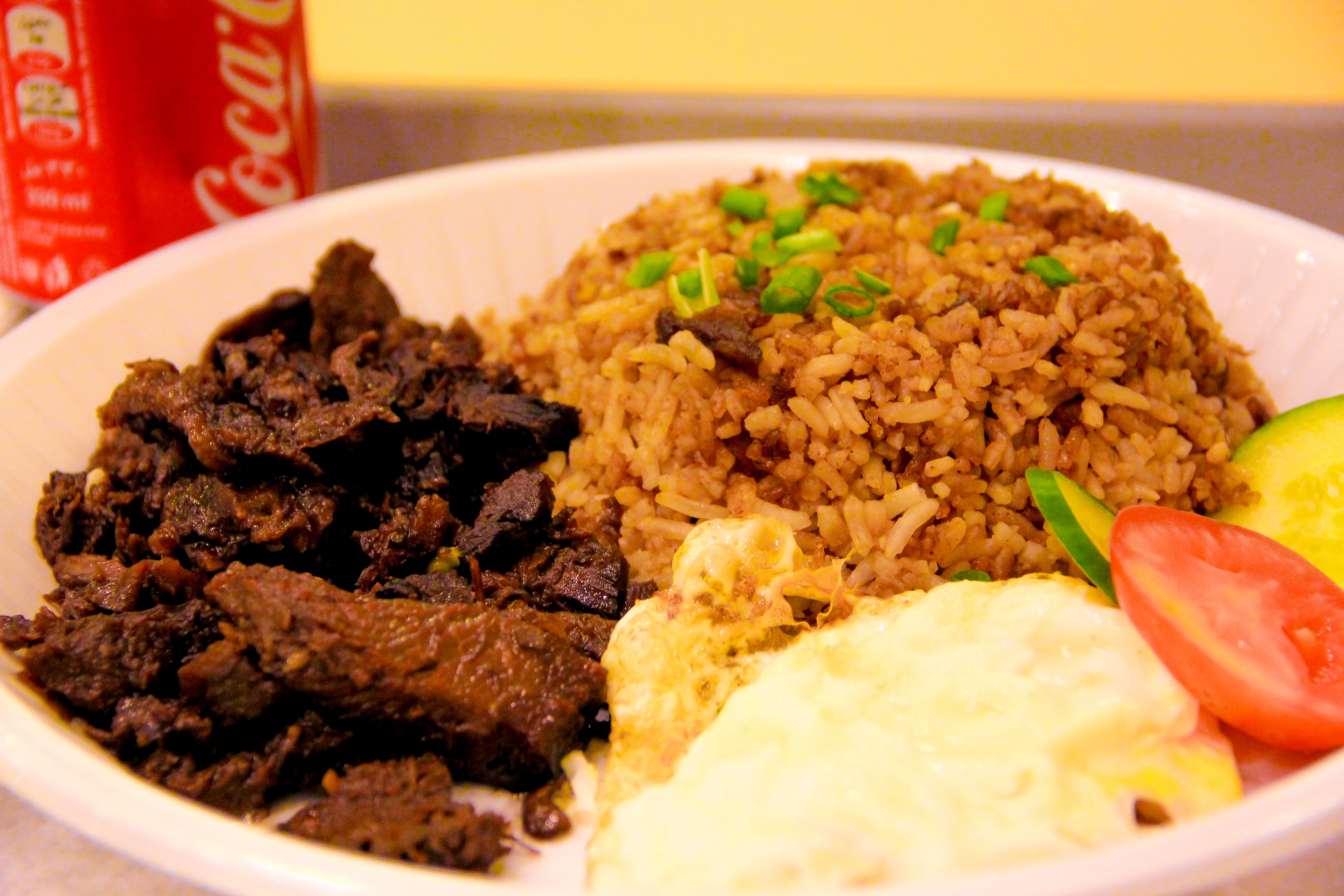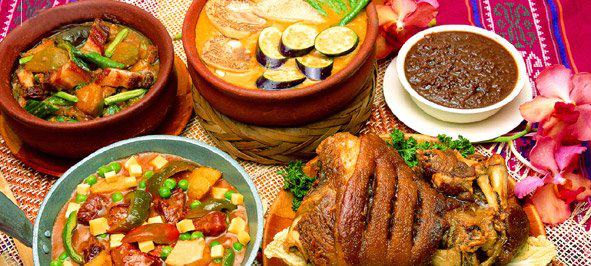|
Sinangag
''Sinangag'' (), also called garlic fried rice or garlic rice, is a Filipino fried rice dish cooked by stir-frying pre-cooked rice with garlic. The rice used is preferably stale, usually leftover cooked rice from the previous day, as it results in rice that is slightly fermented and firmer. It is garnished with toasted garlic, rock salt, black pepper and sometimes chopped scallions. The rice grains are ideally loose and not stuck together. It is rarely eaten on its own, but is usually paired with a "dry" meat dish such as tocino (bacon), ''longganisa'' (sausage), ''tapa'' (dried or cured meat), Spam, or ''daing'' (dried fish), as well as the addition of scrambled or fried eggs. Unlike other types of fried rice, it does not normally use ingredients other than garlic, in order not to overwhelm the flavour of the main dish. In the Visayas regions of the Philippines, ''sinangag'' was traditionally seasoned with '' asín tibuok''. ''Sinangag'' is a common part of a traditional Fili ... [...More Info...] [...Related Items...] OR: [Wikipedia] [Google] [Baidu] |
Tapa (Filipino Cuisine)
''Tapa'' is dried or cured beef, pork, mutton, venison or horse meat, although other meat or even fish may be used. Filipinos prepare ''tapa'' by using thin slices of meat and curing these with salt and spices as a preservation method. ''Tapa'' is often cooked fried or grilled. When served with fried rice and fried egg, it is known as ''tapsilog,'' a portmanteau of the Tagalog words ''tapa'', '' sinangag'' (fried rice) and ''itlog'' (egg). It sometimes comes with atchara, pickled papaya strips, or sliced tomatoes as side dish. Vinegar or ketchup is usually used as a condiment. Etymology ''Tapa'' in Philippine languages originally meant fish or meat preserved by smoking. In the Spanish Philippines, it came to refer to meats also preserved by other means. It is derived from Proto-Malayo-Polynesian ''*tapa'', which in turn is derived from Proto-Austronesian ''*Capa''. '' Tinapa'' (literally "prepared by smoking") is another cognate, though it usually refers to smoked fish. Di ... [...More Info...] [...Related Items...] OR: [Wikipedia] [Google] [Baidu] |
Silog
''Silog'' is a class of Filipino breakfast dishes containing ''sinangag'' ( garlic fried rice) and ''itlog'' ("egg"; in context, fried egg "sunny side up"). They are served with various accompanying savory dishes (), usually fried meat dishes such as tapa, longganisa or ham. The name of the accompanying dish determines the portmanteau name of the ''silog''; for example, the former three would be known as tapsilog, longsilog, and hamsilog. History The first type of silog to be named as such was the '' tapsilog''. It was originally intended to be quick breakfast or late-night hangover fare. It developed from ''tapsi'', which referred to meals of beef ''tapa'' and ''sinangag'' with no fried egg explicitly mentioned, and diners which mainly or exclusively served such meals were called ''tapahan'' or ''tapsihan'' in Filipino. The term ''tapsilog'' was originally established in the 1980s and came from the Tapsi ni Vivian ("Vivian's Tapsi") restaurant in Marikina. According to Vivian de ... [...More Info...] [...Related Items...] OR: [Wikipedia] [Google] [Baidu] |
Aligue Fried Rice
Aligue fried rice (), also known as crab fat fried rice or aligue rice, is a Filipino fried rice dish cooked by stir-frying pre-cooked rice with crab fat ('' taba ng talangka'' or ''aligue''), toasted garlic, spring onions, black pepper, rock salt, and optionally butter. It is traditionally a vivid orange-yellow color due to the crab fat. It can be combined with seafood like shrimp and squid and eaten as is, or eaten paired with meat dishes.- - It is a variant of ''sinangag'' (garlic fried rice) and is similar to bagoong fried rice, which uses ''bagoong'' (shrimp paste). See also * Sinangag * Fried rice * Kiampong * Kuning * Sinigapuna ''Sinigapuna'' is a Filipino rice dish cooked with turmeric and other spices. It originates from Kalagan (or Caragan) people of the Caraga and Davao Regions of Mindanao. It is similar to the Maranao '' kuning'', and Indonesian ''nasi kuning' ... References Fried rice Philippine rice dishes {{Philippines-cuisine-stub ... [...More Info...] [...Related Items...] OR: [Wikipedia] [Google] [Baidu] |
Fried Rice
Fried rice is a dish of cooked rice that has been stir-fried in a wok or a frying pan and is usually mixed with other ingredients such as eggs, vegetables, seafood, or meat. It is often eaten by itself or as an accompaniment to another dish. Fried rice is a popular component of East Asian, Southeast Asian and certain South Asian cuisines. As a homemade dish, fried rice is typically made with ingredients left over from other dishes, leading to countless variations. Fried rice first developed during the Sui dynasty in China. Many varieties of fried rice have their own specific list of ingredients. In China, common varieties include Yangzhou fried rice and Hokkien fried rice. Japanese chāhan is considered a Japanese Chinese dish, having derived from Chinese fried rice dishes. In Southeast Asia, similarly constructed Indonesian, Malaysian, and Singaporean ''nasi goreng'' and Thai '' khao phat'' are popular dishes. In the West, most restaurants catering to vegetarians have ... [...More Info...] [...Related Items...] OR: [Wikipedia] [Google] [Baidu] |
Aligue Rice
Aligue fried rice (), also known as crab fat fried rice or aligue rice, is a Filipino fried rice dish cooked by stir-frying pre-cooked rice with crab fat ('' taba ng talangka'' or ''aligue''), toasted garlic, spring onions, black pepper, rock salt, and optionally butter. It is traditionally a vivid orange-yellow color due to the crab fat. It can be combined with seafood like shrimp and squid and eaten as is, or eaten paired with meat dishes.- - It is a variant of ''sinangag'' (garlic fried rice) and is similar to bagoong fried rice, which uses ''bagoong'' (shrimp paste). See also * Sinangag * Fried rice * Kiampong * Kuning * Sinigapuna ''Sinigapuna'' is a Filipino rice dish cooked with turmeric and other spices. It originates from Kalagan (or Caragan) people of the Caraga and Davao Regions of Mindanao. It is similar to the Maranao '' kuning'', and Indonesian ''nasi kuning' ... References Fried rice Philippine rice dishes {{Philippines-cuisine-stub ... [...More Info...] [...Related Items...] OR: [Wikipedia] [Google] [Baidu] |
List Of Fried Rice Dishes
Fried rice is a dish of cooked rice that has been stir-fried in a wok or a frying pan and is usually mixed with other ingredients such as eggs, vegetables, seafood, or meat. It is often eaten by itself or as an accompaniment to another dish. Fried rice is a popular component of East Asian, Southeast Asian and certain South Asian cuisines. As a homemade dish, fried rice is typically made with ingredients left over from other dishes, leading to countless variations. Fried rice first developed during the Sui dynasty in China. Many varieties of fried rice have their own specific list of ingredients. In China, common varieties include Yangzhou fried rice and Hokkien fried rice. Japanese chāhan is considered a Japanese Chinese dish, having derived from Chinese fried rice dishes. In Southeast Asia, similarly constructed Indonesian, Malaysian, and Singaporean ''nasi goreng'' and Thai '' khao phat'' are popular dishes. In the West, most restaurants catering to vegetarians have inv ... [...More Info...] [...Related Items...] OR: [Wikipedia] [Google] [Baidu] |
Cuisine Of The Philippines
Filipino cuisine is composed of the cuisines of more than a hundred distinct ethnolinguistic groups found throughout the Philippine archipelago. A majority of mainstream Filipino dishes that comprise Filipino cuisine are from the food traditions of various ethnolinguistic groups and tribes of the archipelago, including the Ilocano, Pangasinan, Kapampangan, Tagalog, Bicolano, Visayan, Chavacano, and Maranao ethnolinguistic groups. The dishes associated with these groups evolved over the centuries from a largely indigenous (largely Austronesian) base shared with maritime Southeast Asia with varied influences from Chinese, Spanish, and American cuisines, in line with the major waves of influence that had enriched the cultures of the archipelago, and adapted using indigenous ingredients to meet local preferences. "Philippine Cuisine." ... [...More Info...] [...Related Items...] OR: [Wikipedia] [Google] [Baidu] |
Filipino Cuisine
Filipino cuisine is composed of the cuisines of more than a hundred distinct Ethnic groups in the Philippines, ethnolinguistic groups found throughout the Philippines, Philippine archipelago. A majority of mainstream Filipino dishes that comprise Filipino cuisine are from the food traditions of various ethnolinguistic groups and tribes of the archipelago, including the Ilocano people, Ilocano, Pangasinan people, Pangasinan, Kapampangan people, Kapampangan, Tagalog people, Tagalog, Bicolano people, Bicolano, Visayan, Chavacano, and Maranao people, Maranao ethnolinguistic groups. The dishes associated with these groups evolved over the centuries from a largely indigenous (largely Austronesian peoples, Austronesian) base shared with maritime Southeast Asia with varied influences from Chinese cuisine, Chinese, Spanish cuisine, Spanish, and American cuisine, American cuisines, in line with the major waves of influence that had enriched the cultures of the archipelago, and adapted us ... [...More Info...] [...Related Items...] OR: [Wikipedia] [Google] [Baidu] |
Fried Rice
Fried rice is a dish of cooked rice that has been stir-fried in a wok or a frying pan and is usually mixed with other ingredients such as eggs, vegetables, seafood, or meat. It is often eaten by itself or as an accompaniment to another dish. Fried rice is a popular component of East Asian, Southeast Asian and certain South Asian cuisines. As a homemade dish, fried rice is typically made with ingredients left over from other dishes, leading to countless variations. Fried rice first developed during the Sui dynasty in China. Many varieties of fried rice have their own specific list of ingredients. In China, common varieties include Yangzhou fried rice and Hokkien fried rice. Japanese chāhan is considered a Japanese Chinese dish, having derived from Chinese fried rice dishes. In Southeast Asia, similarly constructed Indonesian, Malaysian, and Singaporean ''nasi goreng'' and Thai '' khao phat'' are popular dishes. In the West, most restaurants catering to vegetarians have ... [...More Info...] [...Related Items...] OR: [Wikipedia] [Google] [Baidu] |
Spam (food)
Spam (stylized in all-caps) is a brand of lunch meat ( processed canned pork and ham) made by Hormel Foods Corporation, an American multinational food processing company. It was introduced in the United States in 1937 and gained popularity worldwide after its use during World War II. , Spam was sold in 41 countries, and trademarked in more than 100, on six continents. Spam's main ingredients are pork shoulder and ham, with salt, water, modified potato starch (as a binder), sugar, and sodium nitrite (as a preservative). Natural gelatin is formed during cooking in its cans on the production line. It is available in different flavors, some using different meats, as well as in "lite" and lower-sodium versions. Spam is precooked, making it safe to consume straight from the can, but it is often cooked further for taste. Concerns about Spam's nutritional attributes have been raised because it contains twice as much of the daily dietary recommendation of fat as it does of ... [...More Info...] [...Related Items...] OR: [Wikipedia] [Google] [Baidu] |
Kiampong
''Kiampong'', also spelled as ''kiampung'' or ''kiampeng'', is a Filipino glutinous rice casserole. Its name originates from Philippine Hokkien for "salty rice" (). It is a common traditional dish for Chinese Filipino families. It has many variants, but typically comprise two steps in cooking. The meat (usually pork) and Chinese sausages are first cooked in a sauce similar to Philippine adobo with garlic, soy sauce, vinegar, sugar, and ground black pepper. Various vegetables (typically mustard greens) and root crops like taro can also be added, depending on the recipe. This is then added to a pot along with glutinous rice and mixed thoroughly before cooking the rice. Toasted nuts and scallions are added before serving. See also * Morisqueta tostada *Kuning * List of casseroles *Lugaw *Sinangag ''Sinangag'' (), also called garlic fried rice or garlic rice, is a Filipino fried rice dish cooked by stir-frying pre-cooked rice with garlic. The rice used is preferably stale, us ... [...More Info...] [...Related Items...] OR: [Wikipedia] [Google] [Baidu] |




